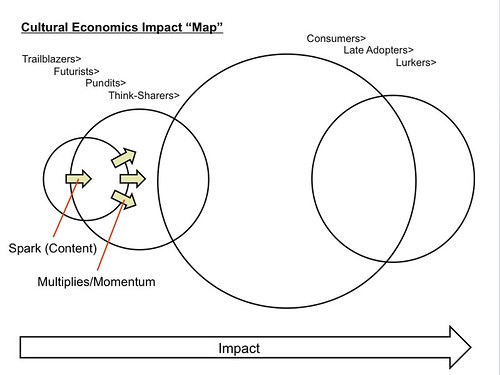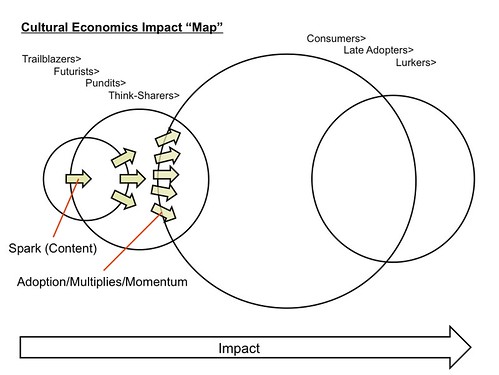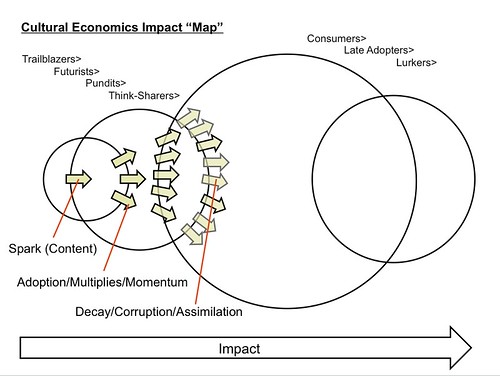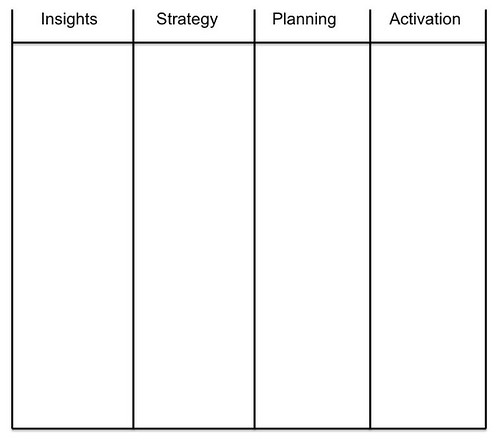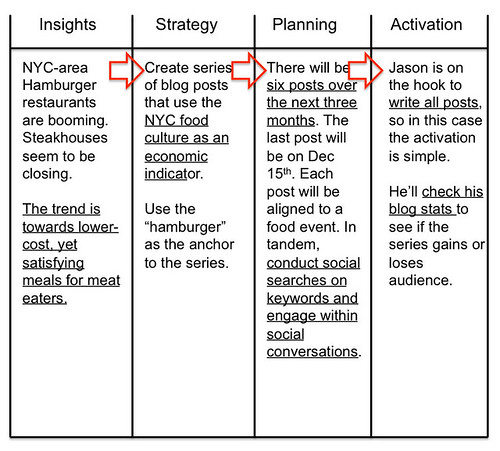The Retail Influence Story is a Flow from Pop-Ups to Pop-Ups
Walking down 5th ave in my Brooklyn neighborhood last weekend I had a moment of cultural economic clarity. The cadence of the shops, of different types and at different states of retail trends, told a story. There was a clear pattern, a trend wave that meandered from “new” to “staid” to “retro” and back. There’s one particular block on 5th ave, between Union and Sackett that tells the story. On that block are both Brooklyn Industries and Goorin Brothers Hatmakers mixed in with the old and new shops. Both are “Local” style operations that channel the vibe of nostalgia for goodness and originality. These two operations are veterans of the “Local” style yet their growth mimics the path of well established “staid” brands.
Here in Brooklyn there’s a burgeoning “local made” and “slow” movement similar to other cities such as Portland and San Francisco. Nearly all of these new local brands have the name “Brooklyn” as part of their branding in order to show their genuineness. I’ve also noticed a wave of “pop-up” and “food truck” style retail experiments this past summer. There’s a pattern happening. A connection of trends. Here’s a matrix I drafted to plot this pattern…
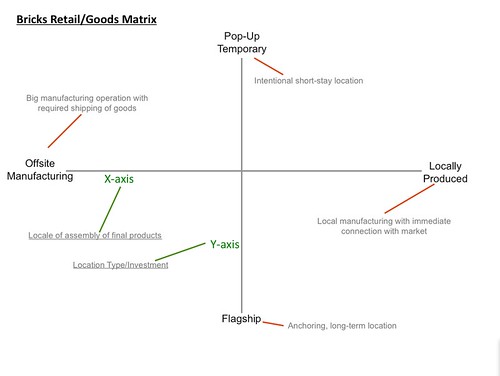
The X-axis defines where the items for sale are produced; offsite manufacturer is on one end…locally manufactured is on the other. The Y-axis defines whether the store is a temporary pop-up on one end…and a flagship (showroom for the brand experience) space on the other. I plotted a handful of retail brands within this matrix to map out the pattern.
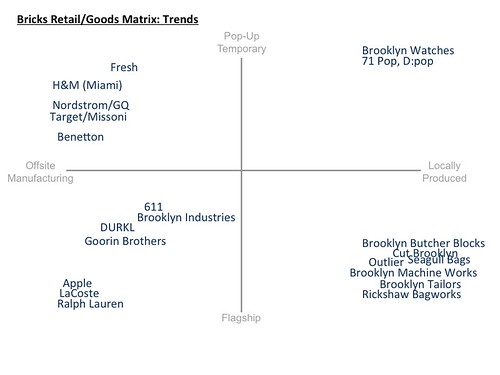
The brands cluster on the matrix. At the top left are brands that are testing out the panache of having a pop-up experience. These are not focussed on sales as much as they are creating local instances to showcase their brands. At the top right are the true “pop-ups” who choose the pop-up space to sell their goods, relying on the agility and panache of a pop-up presence to lower costs while still reaching their market. At the bottom left are the staid brands who are building flagship style locations. Just above them are the new wave of brands that are seeking to have similar coherent successes. At the bottom are new brands, creating truly locally manufactured items with a strong element of “place” infused into their products. Thus why so many have “Brooklyn” in their brand names. Some have stores, some have store-hours at their “factories.”
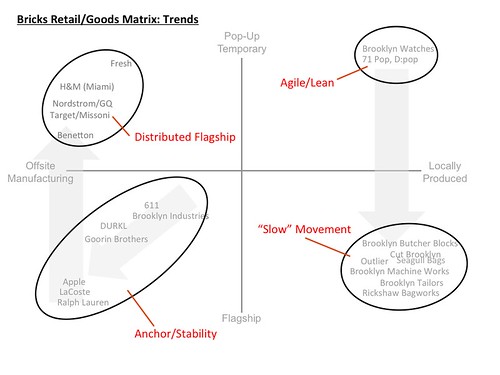
I labeled these clusters based on their tone and style. At the top left are the “Distributed Flagships.” These pop-ups are seeking to create local brand awareness by appearing locally and temporarily to create buzz and awareness. At the top right are the “Agile/Lean” businesses, the start-up, who require a pop-up livelihood to build their brands. At the bottom left are the “Anchors of Stability.” This group seeks to further install themselves as the hegemonic international brands. I added the seemingly upstart brands such as Goorin Hats and Brooklyn Industries to this group as both are seeking national expansion and adoption. They are keeping the “Local” flavor while aspiring to become national brands. At the bottom right are the brands that embody the “Slow Food” movement which is being adopted by other categories other than food. These brands could be the “Slow Manufacturing” or “Slow Brand” movement. When mapped together, the trend wave becomes clear:
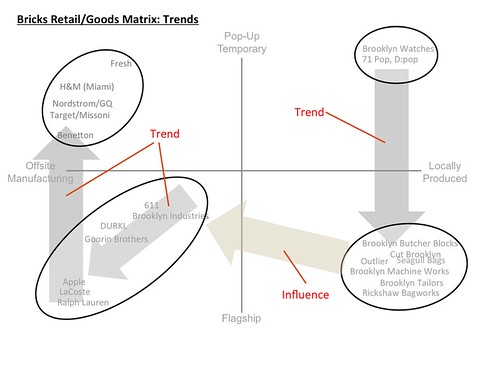
The story goes like this…The energy and innovations of the pop-ups are becoming manifested in the “Slow Brand” movement which is the next generation of the “Local” movement. These Slow Brands are influencing the earlier wave of “Local” brands who have now moved on to attempt to become hegemonic brands. These new brands are rushing at the gates of the hegemonic brands, inspring the hegemonic brands take new risks; by trying out the style and tone of the original pop-up movement, but in the way they know how…by re-creating pop-ups as flagships.
Thats the cultural economic story. The pop-up and slow movements are influencing the hegemonic brands to take new risks. Let’s apply this story to “The Map.” (If you’re unfamiliar with the ACE Map read this post)

When added to the map the impact roles of these clusters of brands becomes clear. What does this mean for you? For one, if you’re seeking to influence this category, you can define your tactics by understanding where these groups sit within the flow of influence. If you’re seeking to create influence and impact from your own agenda, see if you can locate yourself or your target influencers on this map and compare your path to the retail path identified in this post. What would you change about your program? What can you do differently now?
If you want to see the retail trends that will eventually live within the anchor brands, go visit the pop-ups. If you’re interested in seeing this next-wave in a more mature state, go visit the Slow Brands.
Please let me know your questions. -JM
—–
Here’s a list of all retailers mentioned…
Fresh Pop-up Truck: http://blog.birchbox.com/post/27861814802/visit-the-fresh-pop-up-truck-in-nyc-this-week
H&M Pop-up in Miami: http://miami.cbslocal.com/2012/06/01/hm-pop-up-store-opens-friday-in-miami-beach/
Nordstrom/GQ Men’s Pop-up: http://www.freshnessmag.com/2012/09/06/gq-nordstrom-mens-shop-pop-up-store-new-york/
Target/Missoni Pop-up: http://ny.racked.com/archives/2011/08/29/the_missoni_x_target_popup_shop_takes_shape_in_bryant_park.php
Benetton’s Pop-up: http://www.benetton.com/popup/image-gallery/ny_store_2/
611 Lifestyle: http://phillystylemag.com/style/articles/the-magic-number
Brooklyn Industries: http://www.timeout.com/newyork/shopping/brooklyn-industries-chains
DURKL: https://popularise.com/cities/1/neighborhoods/1/projects/1/concepts/31
Goorin Brothers: http://www.nola.com/fashion/index.ssf/2012/05/goorin_brothers_hats_to_open_m.html
LaCoste: http://www.refinery29.com/lacoste-fifth-avenue-store
Ralph Lauren: http://www.nytimes.com/2008/03/16/realestate/16scap.html
Brooklyn Watches: http://www.acontinuouslean.com/2012/06/18/hand-made-watches-from-brooklyn/
D:Pop: http://dhivedetroit.org/dpop/
Cut Brooklyn: http://www.nytimes.com/2011/01/12/dining/12knives.html
Outlier Clothing: http://www.fav.co/reviews/andrew-hunter/outlier-clothing
Seagull Bags: http://www.bizjournals.com/columbus/print-edition/2012/07/13/bicyclists-flock-to-seagull-bags.html
Brooklyn Machine Works: http://www.highsnobiety.com/tag/brooklyn-machine-works/
Brooklyn Tailors: http://nymag.com/listings/stores/brooklyn-tailors/
Rickshaw Bagworks: http://www.pcmag.com/article2/0,2817,2351890,00.asp


